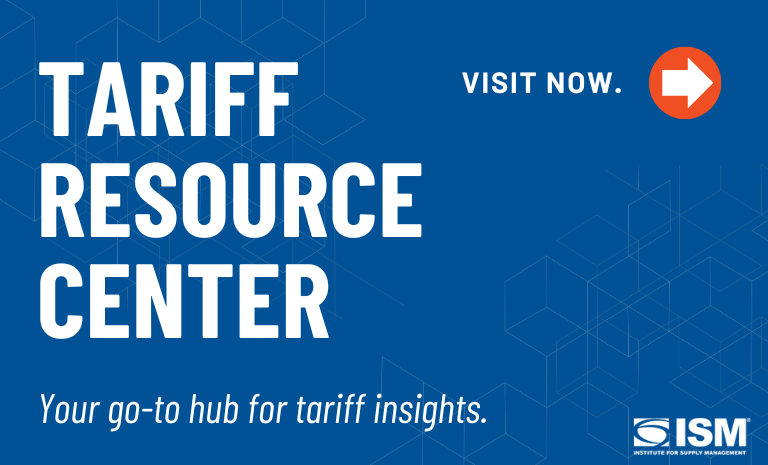Supply Chain Roundtable: Back to School

Fall is in the air, and there are few places where the season is felt more strongly than on college campuses.
As supply chain students return to school and their studies, the monthly roundtable of experts from Institute for Supply Management® (ISM®) discusses what they’ve been learning — and what they should be learning — in between extracurricular activities like college football.
On that note, the roundtable welcomes its newest addition from the transfer portal: Linda Aaron, MBA, an ISM Subject Matter Expert who brings decades of experience in a wide range of supply chain disciplines for the U.S. Army and such companies as Boeing, Amazon Web Services and Accenture.
She joins Thomas W. Derry, ISM CEO; Jim Fleming, CPSM, CPSD, Manager, Product Development and Innovation; and Michelle Rohlwing, MBA, Manager, Product Development, Innovation and Learning, to also discuss how procurement and finance can best collaborate to achieve company objectives, and how humans can make artificial intelligence (AI) better in a world that perhaps too often thinks in terms of the other way around.
The roundtable was conducted before the U.S. Federal Reserve approved a quarter-point interest-rate cut last week, so our panelists will survey the supply chain landscape and evaluate the impact in the October edition.
Q: A feature in the September/October issue of Inside Supply Management® discusses the advantages of collaboration between the CFO and chief supply chain officer (CSCO). How can procurement and finance best work to balance the need for cost efficiency with the necessity for supply availability, resilience and innovation?
Aaron: In today’s environment of geopolitical instability, shifting trade regulations, inflationary pressure and supply chain disruptions, the relationship between procurement and finance has become a strategic cornerstone. CFOs and CSCOs must lead together with a unified approach that transforms external volatility into internal strength.
Modern supply chains are exposed to risks that evolve rapidly. Tariffs, sanctions and regional conflicts can impact sourcing, pricing and availability overnight. In this climate, finance must support procurement in making bold, forward-looking investments in supplier diversification, nearshoring and innovation. These decisions may increase short-term costs but are essential to long-term resilience and customer trust.
Real-time visibility is no longer a luxury. Shared access to data platforms allows both functions to monitor supplier health, inventory risk and geopolitical exposure. This transparency enables faster, more informed decisions that protect margins and continuity. Integrated planning is also critical. CFOs and CSCOs must align on strategic priorities that reflect today’s uncertainty. Capital must be deployed to initiatives that not only manage cost but also enable agility, sustainability and competitive advantage.
This is not just collaboration. It is strategic co-leadership in a world where supply chain decisions directly shape financial outcomes and enterprise resilience.
Fleming: Corporate executives create strategic plans that align with vision and missions, expected product portfolios, governance and financial performance (profit margins, shareholder value, cash flow and the like).
CPOs/CSCOs and their staffs should ensure they are aligned with the strategic plans. Balancing cost efficiency must start with a stronger partnership with the finance department. Syncing the two professions allows a better understanding of the challenges. Consider cost of goods sold (COGS) on the profit and loss statement. A single factor such as Inventory can generate a robust conversation. Inventory valuation is comprised on three types of inventories: raw materials (RM), work in progress (WIP) and finished goods (FG).
Finance has a goal for this valuation to ensure target profit margins are achieved. To determine the correct RM inventory, supply chain management needs to apply forecast modeling based on current RM, WIP and FG inventory profiles, product demand signals, historical consumption, statistical confidence factors and supplier lead times. From this, joint decisions can be made on the correct balance to preserve revenue and balance costs.
Derry: Jim’s response was great. Just to add a technical finance perspective: Firms use different methodologies to value inventory. Some are first-in, first-out shops. Other options use last-in, first-out (not recognized by generally accepted accounting principles) or weighted average cost. The point is that you need to understand the methodology followed by your accounting team, because it will affect decisions on managing inventory. As we all know, the price of components, ingredients, raw materials or sub-assemblies change over time.
Rohlwing: Standard sales and operations planning (S&OP) processes can provide a strong foundation for collaboration between procurement and finance, but they often need to be enhanced to fully balance these concepts. However, I think it’s a good start. Some ways to enhance S&OP to support procurement and finance collaboration could be: (1) integrating risk management into S&OP dashboards, (2) including supplier performance and innovation KPIs into planning reviews and (3) integrating business planning to marry long-term strategy with short-term needs to be agile. Lastly, leveraging AI and analytics can help to better simulate the trade-offs between these levers.
Q: The current magazine issue also has multiple columns on leading and developing talent in the artificial intelligence (AI) era. How can supply chain leaders effectively integrate AI with human judgment and emotional intelligence to enhance decision-making and improve efficiency?
Fleming: This is the conversation many organizations are striving to figure out. Role clarity and an integrated strategy are a starting point. AI strengths consist of data analysis, pattern recognition, forecasting and automation. Human strengths consist of contextual understanding, ethical reasoning, empathy and relationship management. An integrated strategy of human-in-the-loop allows AI to make recommendations but allows humans to make the final decisions. This acquired skill that can be expanded through routine applications in business situations, scenario planning and strategic planning. It will enable trust to be fostered in the AI modeling and application.
Derry: Again, building on Jim’s thought, a conversation I have been having with executives lately concerns the proficiency (and even preference) for early-career professionals to use AI models as a default option for initial research.
No problem there. What’s potentially missing is the experience of having worked through (name your moment here — the Great Recession, the coronavirus pandemic, the arrival of China as a major trading partner in the 1990s, or another defining event). That’s Jim’s point about context. Ultimately, humans make decisions in times of disruption or crisis. And the “this isn’t my first rodeo” perspective provides a critical thinking context that companies will always need.
Rohlwing: Supply chain managers can integrate AI with human judgment by first identifying where AI can help best, like forecasting or inventory planning. Then, they need to make sure people stay involved in decisions that need context or ethics. They should build systems where AI suggests options, but humans (1) make the final call, (2) train teams to work with AI tools and (3) use feedback to keep improving the tech. The goal should be to make AI a smart assistant, not a replacement.
Aaron: AI is transforming supply chain leadership. It helps us work smarter, move faster, and make better decisions. But supply chain leaders’ role is not just to implement technology. It is to guide their people through change with clarity, compassion, and purpose. AI is powerful, but it is not personal. It cannot connect or inspire. While machines handle data and complexity, humans bring context, creativity and emotional intelligence. Integrating AI is not just a technical shift. It is a human one.
In today’s climate of rapid change and uncertainty, teams need trust and transparency. They need to understand how AI fits into their work and future. This is where thoughtful leadership matters. Using change management frameworks, leaders must lead with patience, communicate clearly, and create space for learning and growth. AI should elevate human potential, not replace it. Leaders must ensure that automation does not erode connection. Ethical behavior, experimentation and decisions grounded in integrity keep people engaged and aligned.
Q: School is back in session. With rare exceptions, supply chain curricula became prevalent at universities in the 2000s and early 2010s. How have supply chain programs become more specialized and refined? Which topics should be getting extra attention in classrooms?
Derry: This is one of my favorite soap boxes. As a profession, we need to widen the aperture on the results we are driving. We need to learn and use all the tools and methods, for sure. But we need to orient our results to the financial metrics by which business performance is measured: for example, earnings per share, working capital and inventory turns. I strongly encourage college and universities to educate the next generation of professionals in using the core knowledge, tools and methods to drive to these results, understanding how their decisions affect these measures. That’s the next frontier for our profession.
Rohlwing: Supply chain education has become more specialized, with programs now emphasizing resilience, sustainability and tech-driven decision-making. Classrooms should focus more on AI and analytics, global risk, cybersecurity and supplier innovation to prepare students for the complexity and agility today’s demanding supply chains.
Aaron: Supply chain education has made progress, but the pace of industry change demands more. What students are learning must reflect the professional realities they will face. Outdated content creates a gap between talent and the challenges we face today. Programs need to focus on developing critical thinkers who can navigate complexity and make decisions in real time. Real-world scenarios should be central to the curriculum, not just theory. Students must learn to adapt, lead and solve problems with confidence.
We also need more doers. On-the-job training during college is essential. Immersive experiences build capability and prepare students to contribute from day one. Exposure to supply chain automation, digital tools and change management should be prioritized. These areas are often underdeveloped, yet they are critical to transformation. The goal is to prepare students not just for roles, but for impact. When we teach them to think strategically, act decisively and lead with agility, we close the gap between education and the real world.
Fleming: Many leading universities have expanded beyond the standard building blocks of supply chain management (sourcing, negotiation, cost and price management, logistics, S&OP) into integrated solutions. As the complexity of global supply chains continues to increase, focus areas such as advanced analytic simulations, resiliency, strategic transformation and technology integration are becoming more prevalent. Similar to engineering, where basic math, chemistry and physics are foundational but require calculus and molecular modeling to solve complex world problems, supply chain management requires this level of advanced expertise to keep corporations successful. It is encouraging that supply chain students are acquiring more advanced skills in their education.

